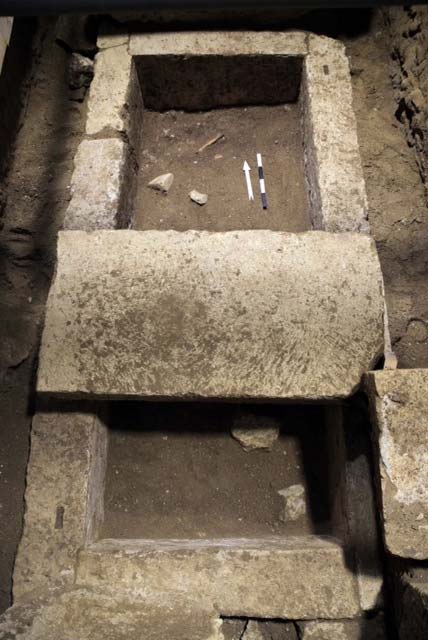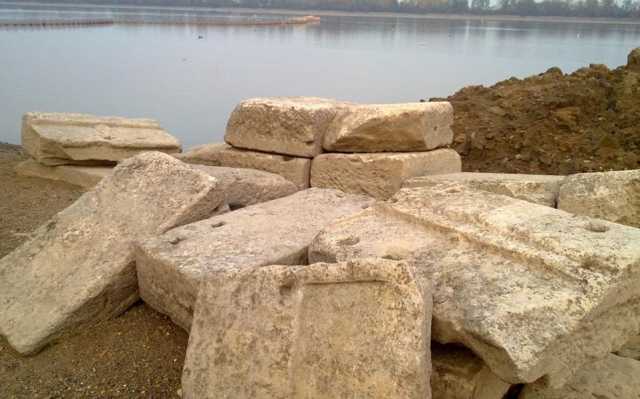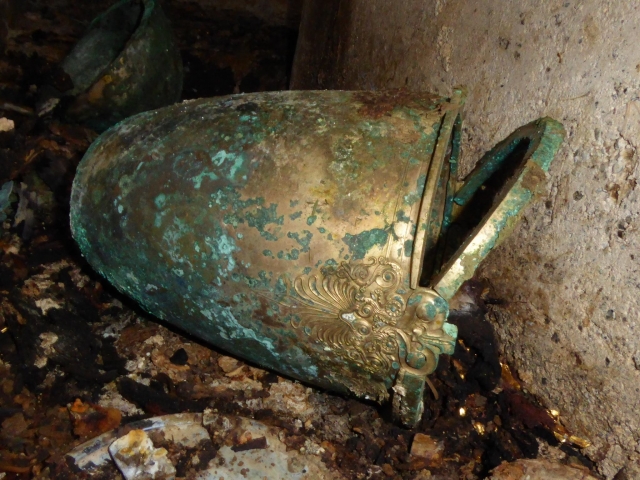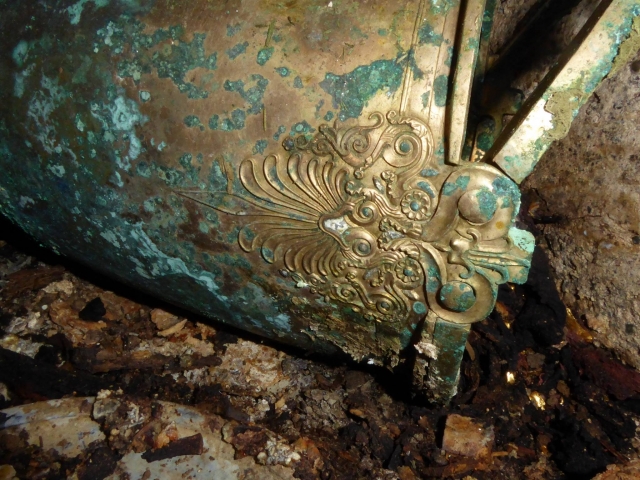Photos: Hellenic Ministry of Culture
Archaeologists conducting the excavations on the Kasta hill near Amphipolis have discovered a large grave and a skeleton in it, as announced by the Hellenic Ministry of Culture. According to spokeswoman for the excavations Anna Panagiotarea, the deceased must have been a very noble person, because only this can explain the construction of such a large burial complex.

The grave is in the shape of a box and is constructed of limestone blocks. It has been discovered at a depth of 1.60 m below the floor of the third chamber of the tomb. Its external dimensions are as follows: length 3.23 m, width 1.56 m and established height 1 m. The excavations have uncovered supports of the ceiling of the grave, showing that its height was at least 1.80 m.

A 2.35 m long and 0.54 m wide ditch had been dug into the grave and a wooden coffin had been placed in it. Scattered iron and copper nails as well as pieces of ornaments made of bones and glass have also been discovered at the site. After the new discovery, the total height of the third chamber from the top of the dome to the floor of the tomb is 8.90 m.

The skeleton of the deceased has been found inside and outside the tomb. It is not yet clear whether it is male or female. The bones will be transferred and analyzed by all means available to modern science.
The communication of the Ministry states that the grave complex was a public project the construction of which used the largest amount of marble on the territory of ancient Macedonia. "Let me recall that the mound is 33 m high and the statue of the lion, which is 15.84 m high, was placed on it. The sphinxes, caryatids and the impressive mosaic depicting the abduction of Persephone, as well as the dyed marble architraves, all show a unique and very original monument synthesizing various elements. This is a very expensive structure, the cost of which obviously could not have been covered by one person. Probably we are talking about a tomb that was dedicated to a man who, after his death, was proclaimed an honour-deserving person by the society of his time," said spokeswoman for the excavations Anna Panagiotarea.
In addition, the study of the scattered pieces of marble that are established to have been parts of the enclosure is continuing in order for the restoration works on the tomb to start. The pieces are about 500 in number and they have been found in the area where the Lion of Amphipolis stands today. A few days ago, after the level of Lake Kerkini declined, archaeologists discovered about 100 parts of the enclosure, such as cornices, columns and coronations. They had been transferred there in 1936 during the construction of the dam of the lake.

Dust sifting, the construction works of supports and the restoration works on the tomb are underway too, attaching particular attention to the search for the missing pieces of the puzzle.
On 22 November, Minister of Culture and Sports Kostas Tasoulas will give a press conference at Amphipolis Museum, where he will announce how the excavations of the mound will continue. A week later, on 29 November, head of the excavations Catherine Peristeri will present the results of her work in the amphitheatre of the Ministry of Culture in Athens.
At the same time, archaeologists from Aristotle University of Thessaloniki Angeliki Kotaridi announced that they have discovered in the necropolis in Aegae (the ancient capital of the Macedonian kingdom, adjacent to modern Vergina – author’s note) a grave that probably has not been looted by treasure hunters.
The head of the excavations has posted on her Facebook profile a photo of the vessel discovered in the grave of the man who was buried in the era when Alexander the Great lived. Kotaridi wrote the following:
"In the cemetery mounds in Aegae we have discovered a big built-up grave (in the form of a box, not a church, i.e. of the so-called "Macedonian" graves), which has not been looted. This is a great exception, accounting for the fact that Aegae necropolis was looted by the Gauls, hirelings of King Pyrrhus in 276 BC and we rarely have the chance of finding intact graves.
The deceased is a man who died in the era of Alexander the Great (336-323 BC). We have discovered some interesting funerary gifts, which we will coincidentally present at the first major exhibition prepared within the context of the opening of the new Museum of Aegae.

Photo: Angeliki Kotaridi
To get an idea of the picture revealed to us, here is a photo of the bucket (a vessel used at feasts, in which they mixed wine with water) in the place where we discovered it, fallen on the floor of the grave. The variety of "waste matters" that are seen around it are the remains of organic materials, wood, etc., from the bed of the deceased. And here is a detail of the decoration of the vessel so as to be able to appreciate the exceptional level of metal working in Ancient Macedonia".
